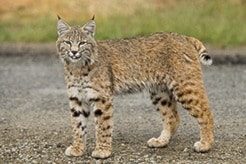Flavio NienowLakes District News
Since last year a study has been under way at the University of British Columbia Okanagan to find out if climate change has been changing the distribution of bobcats and lynx.
Before this study began, the northern limit of bobcats, typically found in southern parts of the province, was believed to be around Williams Lake.
Preliminary results of the study now suggest that the northern limit is somewhere around Quesnel and Prince George.
“The study has found that bobcats have been detected much farther north than I expected, even around Prince George and Houston,” said T.J. Gooliaff, a biology masters student at the University of British Columbia Okanagan.
“When I found out about the bobcat in Houston, I was completely shocked,” he said. “Not only is that extremely far north, but it is also quite far west, deep in lynx country.”
Gooliaff said lynx have been detected throughout the province, typically at high elevations as expected.
Earlier this year the public was requested to submit photos of bobcats and lynx to map the current distribution of both species in B.C. Over 3000 photos from all across the province were submitted.
“The study is still ongoing,” explained Gooliaff. “So far the response has been great.”
Historically, bobcats and lynx have been typically separated by snow depth.
Lynx have extremely long legs and large snowshoe-like paws, making them well adapted for traveling across deep snow. They are found in the boreal forests across Canada and Alaska.
In contrast, bobcats are heavier, have small feet, and sink into the snow.
They are found throughout the deserts and grasslands of the contiguous United States, as well as Southern Canada.
However, climate change has led to earlier springs and lower snow levels in Western North America. As a result, suitable bobcat habitat may now be present in new areas of B.C.
As the study continues, researchers are asking the public to continue submitting photos of bobcats and lynx captured by trail cameras, or conventional cameras, from all corners of the province and from all time periods.
Gooliaff said the photos do not have to be “great photography.”
“They just have to show a bobcat or a lynx, or even just a part of one; photos can be blurry or dark and don’t even have to clearly show which cat species is present.”
When sending your photos, make sure to include both the date and location of each photo. The location should be as specific as possible - most preferred is universal transverse mercator or latitude/longitude coordinates. If that information is not available, researches ask that you provide the name of the nearest road or landmark (including distance and direction from road or landmark), nearest town (including distance and direction from town) or watershed.
Submitted photos will not be published or shared with anyone without permission, and photographers will retain ownership of their photos.
Photos should be submitted to T.J. Gooliaff at tj.gooliaff@ubc.ca
The study is being conducted in partnership with the B.C. Ministry of Environment and is expected to be completed next summer.
